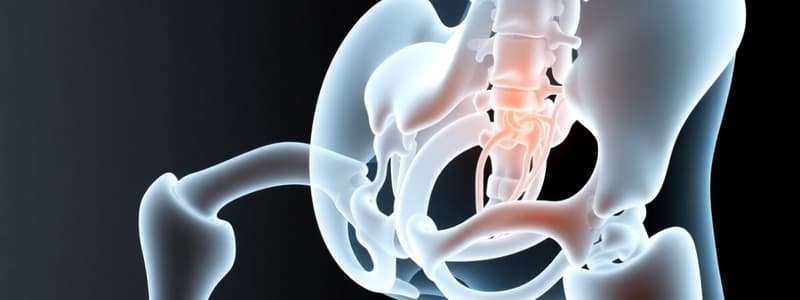Podcast
Questions and Answers
What is the degree of lateral tilt of the pelvis in unilateral stance due to the swing leg?
What is the degree of lateral tilt of the pelvis in unilateral stance due to the swing leg?
- 5°
- 8° (correct)
- 10°
- 12°
The total abduction-adduction motion of the knee is significant due to the stable collateral ligaments supporting the joint.
The total abduction-adduction motion of the knee is significant due to the stable collateral ligaments supporting the joint.
False (B)
What is the position of the hip at initial contact during gait?
What is the position of the hip at initial contact during gait?
adducted
During the swing phase, the subtalar joint returns to _____ by the time the limb is in terminal swing.
During the swing phase, the subtalar joint returns to _____ by the time the limb is in terminal swing.
Match the following joints with their motions during gait:
Match the following joints with their motions during gait:
What is the primary benefit of the lateral drop of the pelvis during gait?
What is the primary benefit of the lateral drop of the pelvis during gait?
The hip abducts about 10° during the swing phase to assist in foot clearance.
The hip abducts about 10° during the swing phase to assist in foot clearance.
What muscles are put on a slight stretch during the lateral drop of the pelvis?
What muscles are put on a slight stretch during the lateral drop of the pelvis?
The maximum range of eversion of the subtalar joint during early midstance is approximately _____ degrees.
The maximum range of eversion of the subtalar joint during early midstance is approximately _____ degrees.
What is the maximum degree of abduction the knee reaches at initial contact?
What is the maximum degree of abduction the knee reaches at initial contact?
Flashcards are hidden until you start studying
Study Notes
Frontal Plane Kinematics of the Pelvis
- Pelvis tilts laterally approximately 8° on each side during gait.
- During unilateral stance, the pelvis on the swing leg side tilts downward by 8°.
- This lateral tilt serves to stretch the hip abductor muscles of the stance leg for better force generation.
- This motion also reduces the elevation of the center of mass of the swing leg, helping to conserve energy.
Hip Joint Motion
- At initial contact, the hip is adducted to about 10°.
- This adduction continues to about 15° during the loading response phase.
- Adduction of the hip during stance serves to put the gluteus medius on the stance side on a slight stretch.
- This stretch allows the gluteus medius to generate the forces needed to stabilize the pelvis during single leg stance.
- The hip abducts about 5° during the swing phase to help clear the foot from the ground and returns to neutral by the end of terminal swing.
Knee Joint Motion
- The knee is in slight abduction at initial contact, reaching a maximum of about 3° during this phase.
- During the swing phase, the knee moves into adduction to a maximum of about 8°.
- The knee has a minimal range of motion in abduction-adduction due to the stabilizing collateral ligaments.
Ankle and Foot Motion
- The subtalar joint, a part of the ankle, is in slight inversion at initial contact.
- It quickly moves into eversion after foot contact, reaching a maximum of about 5° by early midstance.
- By midstance, the subtalar joint begins to invert, reaching its maximum inversion of 8° to 11° during preswing.
- During the swing phase, the subtalar joint returns to neutral and is slightly inverted by terminal swing.
Studying That Suits You
Use AI to generate personalized quizzes and flashcards to suit your learning preferences.




